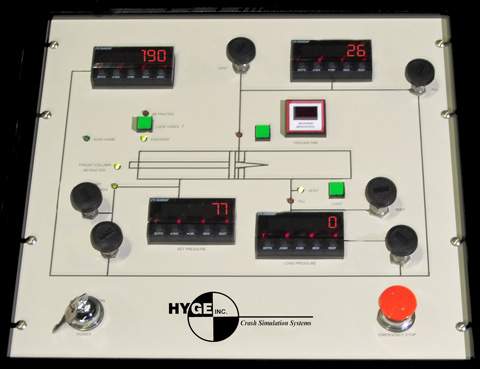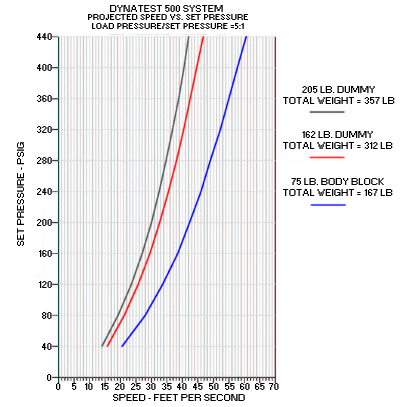
Dynatest 500 Component Crash Simulation system is designed to simulate the effects of a collision in either acceleration or a deceleration mode. In the acceleration mode, the component is sitting at rest and is then accelerated at the same rate that the component was decelerated in an impact. The Dynatest 500’s design provides extremely repeatable and reproducible acceleration pulses, enabling accurate simulation and modeling of crash conditions in non-destructive fashion. The system has proven its repeatability over time. Systems over 40 years old routinely demonstrate repeatability of better than +/- 2%.
The Dynatest 500 can also be used as a velocity generator for the deceleration mode. In this circumstance, the Dynatest 500 accelerates the component to a desired velocity. The customer provides the deceleration mass that absorbs the impact.
The Dynatest 500 typically replaces inclined plane impactors for three important reasons:
1. The inclined plane does not offer sufficient testing flexibility so that speeds can be increased readily.
2. The inclined plane impactor requires a test area with a high ceiling clearance so that the height of the impactor can be adequate to produce the desired speed.
3. The Dynatest system can be mounted in any direction, not just horizontal.
The advantages of the Dynatest 500 are that it is highly flexible and compact. The system is based on the HYGETM crash simulator which is a proven system in place at virtually all of the worlds automobile manufacturers. The Dynatest 500 can be used to test components such as door latches, windshield, transmission, engine, fuel tank mounts, body parts, etc.
Briefly, the system is composed of a six-inch horizontal HYGETM, and an optional small sled that may be equipped with a dummy. In operation, the sled will be energized by the HYGETM accelerator, move about 12 inches horizontally to attain the proper velocity, coast for another 12 inches, and then be abruptly stopped by a special shock absorber to simulate a crash.
The HYGETM system offers precise control of pulse shape, excellent test repeatability and universal acceptance within the automobile manufacturing community.
Dynatest 500 Principle of Operation
APPLICATIONS
Systems are in use worldwide for a variety of automotive and aircraft safety testing applications. Some typical applications include:
- Testing steering columns, engine and transmission mounts
- Testing door latches, fuel tank mounts and instrument panels
- Used as a velocity source for testing components such as bumper systems, door crush, front and rear panels.
- Testing of air-bag systems, including firing circuits, sensors, squibs and air bag units
- Testing auto seat belts, including belt design, webbing, hardware and anchors.
- Testing auto interior parts, such as dash boards, bolsters and head liner trim.
- Biodynamic testing of human subjects to determine biological limits and effects of shock.
- Shock testing of automotive components sold as separate items, such as cellular telephones.
- Shock testing of automobile electronic control modules.
- Testing of aircraft seats, seat belts and components.
- Shock testing of military and space systems and components.
- Standard Pedestrian Safety Tests. Example: 15 Kilogram mass with a velocity of 2 to 20 meters per second, +/- .2 M/S
- Pedal Systems of Vehicles. Example: Apply 50 KiloNewton on a 10 millisecond sawtooth wave Velocity of .5 to 2 meters per second
FEATURES & BENEFITS
- Proven Accuracy -capable of simulating actual crash pulses to within +/-2%.
- Reproducibility – pulses can be accurately reproduced on various Dynatest 500 systems, enabling sharing of test programs and results between components suppliers and OEMs.
- Versatility – Can perform velocity and acceleration tests.
- Mechanically Simple – only 2 moving parts.
- Low Cost Energy- 2200 psi nitrogen
STANDARD SYSTEM CONFIGURATION
The Dynatest system consists of four major components:
- The Actuator, including Load and Set Cylinders and the Thrust Column.
- The Rail System and Carriage.
- The Pneumatic System, which provides pressurized gas for firing the piston.
- The Control Center containing hardware to pressurize and fire the system.
The Dynatest 500 is designed to accelerate a maximum seat rated payload of 210 pounds (95 kg). The system can attain 50 G’s, and up to 45 miles per hour on a 75 pound seated payload. By changing to a different metering pin design, various pulse shapes can be produced. Low speeds and accelerations can be achieved without chatter.
Actuator
The Dynatest actuator consists of stainless steel cylinders each with a 6-inch bore. The actuator and brake are mounted on two frames that are attached to a common foundation that is flush to the floor. The centerline of the accelerator is horizontal and about 3 feet above floor level. Adding or removing fluid will vary the volume of the Set Cylinder.
Metering Pin (Acceleration mode)
The purpose of the metering pin is to throttle the amount of energy transferred to the carriage at any given time during firing, thereby determining the shape of the acceleration pulse. A particular component, in a particular crash situation, will have a waveform determined by modeling or by actual crash tests. Each metering pin is machined to produce the desired pulse shape for a given specimen and set of crash conditions. In addition, aspects of the waveform can be varied through changes in the Set cylinder volume and the gas pressures in each cylinder prior to firing. A 2-½° metering pin, with capability of producing a nominal 40 ms half-sine pulse, is provided as standard. HYGE, INC. offers a metering pin design program, which enables the engineer to enter the characteristics of the desired waveform and automatically generate the required metering pin profile.
Rail and Carriage
A sturdy support located at the end of the guide rails serves as a fixture mount. The mount is guided by bushings on two guide rails which are spaced approximately 12 inches on center. HYGETM can provide a seat fixture as an option. A special hydraulic brake rapidly decelerates the thrust column and acts as a shock absorber.
Pneumatic System
The primary energy source is 2200 psi compressed nitrogen. The customer provided standard bottle will provide approximately 25 firings at 15 miles per hour with an 80 pound body block.
Control Center
 The Dynatest 500 control system provides a graphic interface for the firing sequence. A graphical interface allows the operator to visually determine the status of the system at a glance.
The Dynatest 500 control system provides a graphic interface for the firing sequence. A graphical interface allows the operator to visually determine the status of the system at a glance.
The control system allows the operator to input and monitor the following parameters:
- Set Pressure
- Load Pressure
- Trigger Pressure
The operator is led through the process in the proper sequence and prevents loading of incorrect, unsafe, or out of sequence parameters. Interlocks are hard wired to minimize errors.
The actual firing control can is performed manually from the panel. The operator loads the trigger pressure, disengages the lock yokes and begins the countdown sequencing to firing.

System Performance
The Dynatest 500 is capable of producing a wide variety of shock pulses.
A standard half sine wave metering pin is supplied with the system.
The pulse may be modified by adjusting the HYGETM systems firing parameters.
For example, lower pressures will have a direct bearing on the velocity at the end of the stroke.



